May 27, 2010
Prior to the primary I had seen Doña Ana County District Attorney and Republican Party gubernatorial primary candidate Susana Martinez only once on the trail.
It was at the KOB televised debate. The candidates are from the left: Pete Domenici Jr., Allen Weh, Rep. Janice Arnold-Jones, Doug Turner, and Martinez.
One thing stuck out about the Martinez campaign; the five candidates had agreed that in the audience there would be no signs, or T-shirts of support. Martinez camp showed up wearing her campaign T-shirts.
Some of Weh's supporters wore shirts with much smaller sized text. There were the occasional campaign stickers, but some campaigns followed the agreed upon rules.
KOB had to change its broadcasting plans, which had included a camera dedicated to show the crowd.
The disregard for following agreed upon ground rules will become apparent as being hypocritical later in the campaign year.
 June 10, 2010
June 10, 2010
Then newly nominated Republican Party gubernatorial candidate Susana Martinez attended the Saturday morning group, Conspiracy Brews, sponsored by Rep Janice Arnold-Jones. They were on their way to the New Mexico Federated Republican Woman’s statewide meeting, an Albuquerque fund-raiser and on to an Estancia for a matanza with conservative Democrats. The nominee was willing to answers questions for a few minutes.
The high points of the questioning were: she would encourage Attorney General Gary King to join other AG’s in suing against the recent passage of the health care program, unless the state had a new AG, in GOP candidate Matt Chandler.
When asked what could
she do to stop “illegal aliens” coming from Arizona before November to get
drivers’ licenses?
“It’s the law,” Arnold-Jones said.
“It is the law,” Martinez said, “and the legislature will have to repeal that law.”
She claimed, “the polling was very very favorable at this time. We’ve never had a poll this early showing this favorable for a Republican candidate in a state where we are outnumbered three to one.”
…And we have to make sure we write letters to the editor, we have to start getting on the blogs, wherever there are comments, so there is a balance, saying, no, that’s not correct, go to this site and you’ll see where she has, you know, those ads are wrong or this is incorrect. We’ve got to communicate with people. Every day, while you’re sitting there with a friend at a restaurant, when you’re sitting there, you know, having your haircut, whatever it is talk to people.
“We have hired Ryan Cangiolosi, we stole him from the State Party to be our campaign manager,“ Martinez said about reorganizing the campaign since the primary. Cangiolosi was also Bernalillo County Republican Party Executive Director.
Other additions to the general election campaign staff included:
Personal assistant – Aniesa Ford
Field Operations – Adam Deguire
Operations and Policy Advisor – Matthew Kennicott
“We are hiring a scheduler…” Martinez said. ”We are receiving at least a hundred requests to be places a week.”
“We just hired a communications director, he should be here this weekend and he will be helping with our consultant and the communications is going to go ten-fold overnight. So all of that is in place,” Martinez said. ”We’re bringing him from Washington, D.C.”
When asked if she would be available for a radio interview, she said.
We are, certainly, the media, what we do is communicate with Ryan Cangiolosi, or the office and all of that is going to him and the communications director is figuring out which ones are, and we’re doing all the time. So, yes.
When asked if her limited message through negative campaigning would expand to bigger and more important issues from the legal pedophiles?
I’ll tell you, this is the most interesting part of probably running a campaign is, how you message in 30-seconds important issues that grab someone from going to the refrigerator and staying put to watch the ad, and what we do is poll.
We poll a lot, and it is amazing.
The pollsters, the pollster that we use is very very accurate in this, we followed it to the “T” in the primary.
In… with the ability to formulate our messages and we were on, ahead on the border issue by two weeks. I didn’t think it was the key issue, I really didn’t, but the polls were showing it as a key issue, which put us two weeks ahead of it when Arizona broke.
And we were right on target.
And so, when we did polling after the primary, we asked, what is important to you to know about my candidacy?
And unfortunately, I don’t say unfortunately, I say, what is important to them they say is the cases, they know me because of the cases I’ve, they know me because I’m a fighter for children and the families in my community.
And that’s what grabs someone to sit, to watch it.
Now, are those the important things in our state, are those the important things of our economy that is going down the tubes, and we’re losing jobs?
No, but what is going to grab them long enough to stay put?
And it is corruption, it is the cases, it is ability to root out the corruption form our economy that is killing jobs.
Someone in a business environment the other day sat there and said, well what about the jobs, why aren’t we talking about that?
It was like number seven in the polls.
And it unfortunate, it’s terrible, but keep in mind, while I was sitting, and I tell this story all the time, I’m sitting there at a red light and as the cars are passing by me and the drivers, I’m thinking, that’s a voter, that’s a voter, I’ll never meet them, I mean, I’ll just not ever have a chance to meet with them, and they’ll get to know who I am merely by a thirty-second ad.
And it is amazing those folks that do that and see that, what they remember and how they’re making their decision on just thirty-seconds.
They’re not getting as informed as you all do or as much as the business community does but there a whole lot of voters that make their decisions off of thirty-second ads.
We want more, but that’s where their deciding, and I think that is what made the difference in this election.
Does it make sense, I mean, is that the way it should be, should we be much more informed for all voters?
Yes. But, I understand the frustration, but that’s what’s moving voters and we started to poll day after day after day once are ads there the last four weeks we started to polling constantly and you could see the spread, on just one issue, and how we were messaging it.
Which didn’t cover jobs, which didn’t cover the economy. It was amazing and you have to follow that.
If we want to make a difference, we have to follow that so we’re elected.
So, then you can implement the policies that are necessary knowing where I stand on the economy and reviving the economy, removing the regulations and those sorts of things.
"Cut back on spending and a lot of that is in the growth of government. The good thing is that there are a lot of vacancies,” Martinez said.
“Look at where we’re wasting money. What we buying with this money? In order to make sure, you know what, we don’t need that we can’t afford that, we’re not going to spend money on that,” she said. “So, there’s got to be a really good analysis of the budget, first.”
“Then we have to make sure we start backing out the regulations, so people start coming to, you know, stay here and do, keep their jobs here,” Martinez said.
“The oil and gas industries, our dairies, the regulations are killing them,” she said. “Cap and trade tax, all of those are going to kill our jobs, and that is coming through the executive and the environmental board. We have to back those out,” Martinez said.
On the question of an Arizona type law on immigration, she said that down south in Dona Ana country, we already do that. If you’re arrested for any crime, we find out if you’re in this country legally,” she said.
Martinez didn’t explain why what she said, differed from the Arizona law, which allowed for determining legal, status minus probable cause to believe an unrelated crime had been committed.
“My name is Ched MacQuigg. I write Diogenes’ Six. I’m wondering if you would support having independent reviewers come into state government, like efficiency experts …”
“Yes,“ Martinez said.
“so we’re not asking department directors, show us the inefficiencies in your department,“ MacQuigg asked? “Would you support having truly independent…,“
“Yes,“ Martinez said.
“… people come in, examine the state government, then report directly to the public record,“ MacQuigg said.
“Yes, just this week I had spoken to someone who does just that for private companies as well as government and absolutely," Martinez said. “Yes I would.”
 The new Communications Director Raj Shah, arrived from Texas. New Mexico State Police arrested Shah on an aggravated DWI charge early Sunday morning July 11. Cangiolosi announced Shah was terminated as communications director. The Martinez campaign did not replace Shah right away; Field Operations Director Adam Deguire, left, later assumed the duties as ad-hoc communications director along with Cangiolosi.
The new Communications Director Raj Shah, arrived from Texas. New Mexico State Police arrested Shah on an aggravated DWI charge early Sunday morning July 11. Cangiolosi announced Shah was terminated as communications director. The Martinez campaign did not replace Shah right away; Field Operations Director Adam Deguire, left, later assumed the duties as ad-hoc communications director along with Cangiolosi.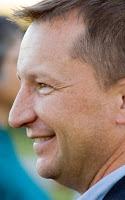 The behind the scenes media consultant, Jay McCleskey of Lincoln Strategy Group, has a history of very tightly controlling the candidate’s message.
The behind the scenes media consultant, Jay McCleskey of Lincoln Strategy Group, has a history of very tightly controlling the candidate’s message.
McCleskey's wife, Nicole Mccleskey's company, Public Opinion Strategies, where she is a Partner, provided polling as a member of Martinez' senior strategy team. She would later be named Deputy Chairman for Transition of the Martinez transition team.
Jay and Nicole McCleskey described their process in winning the Albuquerque Mayoral Election for Richard Berry in 2009 on N.M. Politics with Heath Haussamen with an article, "Berry’s win proves swing voters are back in play."
McCleskey produced TV spots that were questionable to some. One was "Police Stand with Susana" where she is standing in front of current and former law enforcement officers, some wearing uniforms they were no longer allowed to wear and others in violation of departmental policies against using their badge of office for political purposes.
Only one of the five men did not violate some ethical and or departmental rule, that was State Fraternal Order of Police President, Bob Martinez, red shirt. Officers have a constitutional right of free speech, just not when they stand in the uniform of a government body.
Several bloggers
contacted me questioning whether former Bernalillo County Sheriff Darren White,
who was then City of Albuquerque' Chief Administrative Officer for Public
Safety was impersonating a peace officer while wearing a vest emblazoned with "Sheriff"
on it?
A. Impersonating a peace officer consists of:
1. without due
authority exercising or attempting to exercise the functions of a peace
officer; or
2. pretending to be a
peace officer with the intent to deceive another person.
B. Whoever commits impersonating a peace officer is
guilty of a misdemeanor. Upon a second or subsequent conviction, the offender
is guilty of a fourth degree felony.
C. As used in this section, "peace officer"
means any public official or public officer vested by law with a duty to
maintain public order or to make arrests for crime, whether that duty extends
to all crimes or is limited to specific crimes.
The answer,
technically, yes.
Reality? No more so
than every time he put on a uniform when he was paid by a law enforcement
agency. It is my opinion that he's never been much of a cop because he doesn't
hold to the fundamental precepts of policing.
Lincoln Strategy Group won a Reed award from Campaign and Elections Magazine for the best "TV – Republican Statewide Candidate" spot in the country for the year 2010. The winning ad was called "Convicted." It was a push back against an ad produced by National Education Association New Mexico for Democratic opponent, Lt. Gov. Diane Denish featuring a school teacher, Freda Trujillo, who attacked Martinez' education plan. As District Attorney, Martinez' office had prosecuted Trujillo's husband, Jesus Carmona, convicting him of kidnapping for which he received a 23-year sentence.
 August 11, 2010
August 11, 2010
At the August 11, 2010, Susana Martinez Education Reform Press conference, there were 12 members of the media present.
Reporter Natalie Swaby, above, KOAT-TV, placing a wireless microphone on the podium.
Photojournalist Tony Sabato KOAT-TV
Peter St. Cyr, assignment desk editor/twitter, KOAT-TV
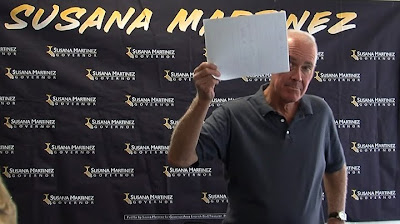 Reporter Stuart Dyson, above, KOB-TV, holding up a white sheet of paper for adjusting the white balance on video cameras. He was supported by two photojournalists.
Reporter Stuart Dyson, above, KOB-TV, holding up a white sheet of paper for adjusting the white balance on video cameras. He was supported by two photojournalists.
Reporter Ian Schwartz KRQE-TV
Photojournalist Robert Pugsley KRQE-TV
Print:
Reporter Kate Nash Santa Fe New Mexican and blogger of Green Chile Chatter
Reporter Sean Olson Albuquerque Journal
Reporter Sue Major Holmes Associated Press
Internet based media:
Ched MacQuigg Diogenes'Six
M.G. Bralley What’s Wrong With This Picture?
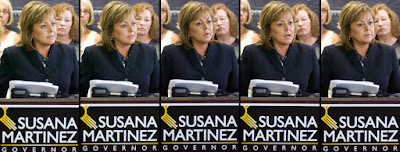 I may have irritated Martinez' Campaign Manager Ryan Cangiolosi when I challenged his shutting down questioning without answering all the questions at the press conference. MacQuigg had attempted to ask a question, but it was not allowed.
I may have irritated Martinez' Campaign Manager Ryan Cangiolosi when I challenged his shutting down questioning without answering all the questions at the press conference. MacQuigg had attempted to ask a question, but it was not allowed.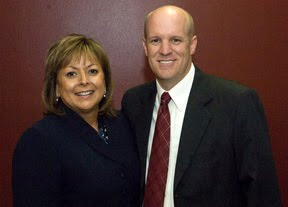 Then, 25-minutes later I was invited to photograph a grip and grin shot of Martinez with Albuquerque/Rio Rancho area GOP House District 60 candidate Tim Lewis, who won.
Then, 25-minutes later I was invited to photograph a grip and grin shot of Martinez with Albuquerque/Rio Rancho area GOP House District 60 candidate Tim Lewis, who won.
After photographing the two, I asked the question MacQuigg wanted answered. Would she be willing to let stakeholders; students and public school teachers have a seat at the table?
Martinez paused, pondered a moment saying, "Hmmm." Cangiolosi placed his hand on her back pushing her out of the room.
"On the record," I later asked him while holding my digital audio recorder.
"Off the record," Cangiolosi said.
"On the record,” I stated placing the recorder closer. “Why shouldn't I post that the Martinez Campaign is unfriendly to bloggers?"
"We invited you here,” Cangiolosi said, “I'll give you a call."
(I was not invited, I found out where the press conference was taking place and showed up.)
Cangiolosi did not communicate with me until September 13, 2010.
I would not see Martinez until the opening of the 2011 Legislative session.
I would not see Martinez until the opening of the 2011 Legislative session.
 So, What’s Wrong With This Picture?
So, What’s Wrong With This Picture?
June 10, 2010
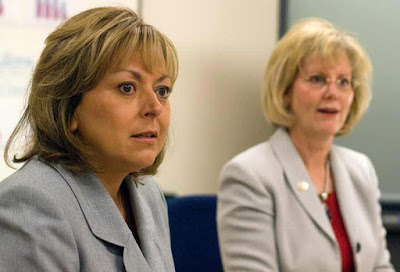 When newly nominated Republican Party gubernatorial candidate Susana Martinez stopped by the Saturday morning group, Conspiracy Brews she was introduced by host Rep. Janice Arnold-Jones.
When newly nominated Republican Party gubernatorial candidate Susana Martinez stopped by the Saturday morning group, Conspiracy Brews she was introduced by host Rep. Janice Arnold-Jones.
None of Martinez’s four Republican primary challengers would stand at a press conference and publicly endorse her.
“The polling was very very favorable at this time,” Martinez said. “We’ve never had a poll this early showing this favorable for a Republican candidate in a state where we are outnumbered three to one” her numbers are wrong.
However, of all the state’s registered voters, the democrats represent 48 percent, the Republican, 32 percent, and the only other option, the declined to state represent 20 percent. At best GOP voters are outnumbered two - to - one.
On “illegal aliens' drivers licenses” question, Arnold-Jones blunted Martinez’ normal statement about her unilaterally banning their issuance, by correctly stating it would take an act of the legislature to change the law. Later in the campaign, Martinez expanded her statement to say all those licenses would be revoked.
For a lawyer, one trained to know the Constitution of the United States and the state, she conveniently forgets that the executive cannot waive a pen and overturn a law. She might challenge it in the courts or try to convince the body that wrote it recently that they were wrong and to rewrite it. She also cannot revoke any license based on her belief that they were issued improperly because she disagrees with the current law that allowed their issuance.
Even if she were able to convince the legislature to change the law, there are several constitutional impediments. including: equal protection, due process, bill of attainder (an act at common law that was used by the crown against an individual to strip them of rights and property originally granted by royal decree), and ex-post facto (writing a law to make some legal act illegal after the fact) come to mind.
A new law might be written to stop further issuance by requiring proof of citizenship or legal residency to acquire a new or replacement license.
Martinez explained that she was chasing the polls, that her pollster had her commenting on the hot button issues instead of the issues even she recognized as the most important problems facing the state, jobs and the economy “It was like number seven in the polls,” Martinez said.
“We’ve got to communicate with people,” Martinez said. She mentioned using the blogs and writing letters to the editor to politically push back against negative or wrong messages.
At the August 11, 2010, Susana Martinez’ Education Reform Press conference, Cangiolosi, new in his multiple roles as campaign manager and communications director, failed to grasp the importance and power of good press.
 The Education Reform Press conference was a great opportunity for Martinez to get her message out. Filling in details by answering questions of the press would have enhanced the message and shown her grasp for the issues beyond her tightly written script.
The Education Reform Press conference was a great opportunity for Martinez to get her message out. Filling in details by answering questions of the press would have enhanced the message and shown her grasp for the issues beyond her tightly written script.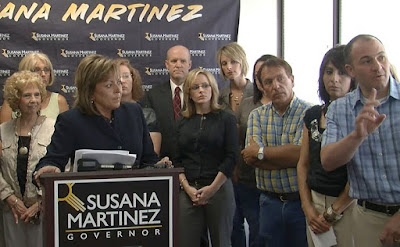 The message was lost when Cangiolosi stopped the questioning. He thought it more important for her to meet 15-20 people who were already in her camp more important than capitalize on the opportunity to reach nearly every citizen of the state.
The message was lost when Cangiolosi stopped the questioning. He thought it more important for her to meet 15-20 people who were already in her camp more important than capitalize on the opportunity to reach nearly every citizen of the state.
There are several thoughts on the proper length of the question period at a press conference.
One can take every question, as Sen. John McCain did during the 2008 primary and up until a July 9th question stumped him, he would take every question. As I wrote in my November 07, 2008,
Why John McCain lost New Mexico.
He would talk to the press forever; inviting the local pool on his “Straight Talk Express” motor home and talking on the airplane with the national traveling press while in flight. He’s referred to members of the media on more than one occasion as “jerks."
A press conference is set for an announced time specific, such as a thirty-minute block or the Presidential prime-time one-hour block where the candidate speaks reading their prepared statement and the remainder of the time is spent fielding questions.
Or the twenty questions of the White House Brady Briefing Room; tradition has it that if the President calls for a press briefing or conference there will be 20 questions.
Before the era of television, when newspapers ruled supreme and the wire services were the life blood of information, there were two power house wire services: United Press International and Associated Press. The first question went to a wire service on an alternating basis followed by the other wire service reporter. It was the duty of the senior White House correspondent to keep count of the number of questions and to say “Thank you Mr. President,” at the end of the answer to the twentieth question.
A committee of the White House Correspondents Association determines the selection of seating in the White House briefing boom, contrary to anything you may have seen on television (especially the West Wing).
To save you some time, just check out John Stewart’s pseudo-history/news take on the White House Press Corps.
There is the Parliamentary approach: where every reporter, agency or outlet gets to ask a question and a follow up, which is considered one question. If every reporter or outlet has had their first questions answered, then upon the second series of question from a reporter, the questioning can be stopped by the staff of the person hosting the press conference. It is a discretionary call by the staff and the candidate and should not be done to the exclusion of any reporter with a question who had not been recognized by the campaign or the subject of the press conference. When some pushy reporter attempts to dominate the press conference with their questions, to the detriment of other reporters, it is not improper for the subject of the press conference or their staff to pass them to make sure everyone has had their question.
I had two colleagues in the room St. Cyr and MacQuigg. When St. Cyr asked a second question, stepping on MacQuigg’s first question, Cangiolosi took it as time to shut down the press conference.
Sean Olson of the Journal had not asked his first question. Because he represents the largest print media outlet in the state, his access would allow him to get is question answered away from the press conference.
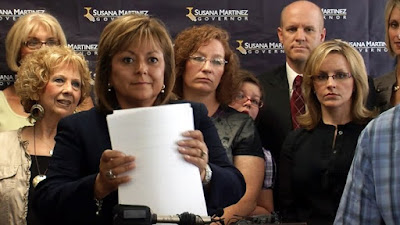 As Martinez gathered up her papers, she looked directly at MacQuigg, but did not attempt to override Cangiolosi’s stepping into the middle of the room.
As Martinez gathered up her papers, she looked directly at MacQuigg, but did not attempt to override Cangiolosi’s stepping into the middle of the room.
This is the least acceptable way to handle a press conference.



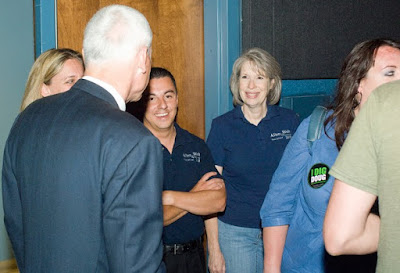











No comments:
Post a Comment